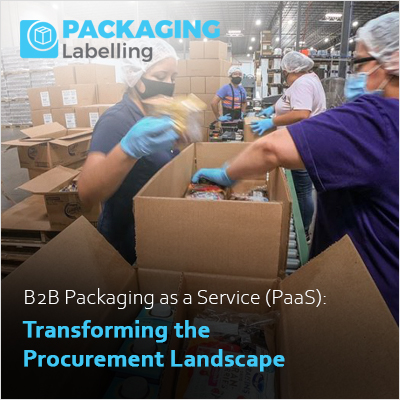B2B Packaging as a Service (PaaS): Transforming the Procurement Landscape

Introduction:
The B2B sector is undergoing a revolutionary transformation with the emergence of Packaging as a Service (PaaS). This innovative approach is reshaping the procurement landscape by offering adaptable and eco-friendly solutions. In this article, we will delve into the critical aspects of B2B Packaging as a Service, exploring its applications, advantages, and the potential influence it holds within the industry.
A) Defining B2B Packaging as a Service (PaaS):
B2B Packaging as a Service represents a paradigm shift in addressing packaging needs within business transactions. Traditionally, companies handled packaging requirements internally or through fixed contracts. However, the PaaS model introduces a dynamic, service-oriented approach by outsourcing the entire packaging process to specialized service providers. This allows businesses to focus on core competencies while benefiting from expert management of their packaging needs.
Shift from Traditional Models:
The traditional packaging model necessitated significant initial investments in infrastructure, machinery, and labor, hindering adaptability to market dynamics. B2B PaaS disrupts this by offering a more flexible, on-demand solution. Similar to other "as a service" models like SaaS and IaaS, businesses pay for packaging services as needed, fostering agility and scalability.
This shift offers numerous benefits. Businesses can tap into the specialized knowledge of service providers, alleviate in-house management responsibilities, and access packaging solutions that are both flexible and scalable. Adopting a service-oriented approach empowers companies to adeptly respond to market fluctuations and navigate seasonal variations.
B) Key Components of B2B PaaS:
1. Design:
- Customized Packaging Solutions: Crafting packaging solutions tailored to individual clients' branding and functional requirements.
- Collaborative Design Processes: Encouraging open communication channels between businesses and service providers during the design phase.
2. Materials:
- Sustainable Material Selection: Prioritizing eco-friendly materials with a focus on recyclability, biodegradability, and reduced environmental impact.
- Innovative Material Technologies: Leveraging cutting-edge materials such as bioplastics and advanced polymers to enhance packaging performance.
3. Production:
- On-Demand Manufacturing: Allowing businesses to adjust production levels based on demand without substantial upfront investments.
- Efficient Production Processes: Optimizing production through lean manufacturing principles, automation, and streamlined workflows.
4. Logistics:
- Integrated Supply Chain Management: Managing the entire packaging supply chain from production to delivery, ensuring a seamless and coordinated process.
- Warehousing and Distribution: Offering warehousing and distribution services for lean inventories and timely delivery.
Contribution to Flexibility and Sustainability:
The design flexibility inherent in B2B PaaS empowers businesses to promptly adjust to shifting market conditions. Through on-demand production and scalable manufacturing, flexibility is heightened as packaging quantities align with real demand, minimizing excess inventory and related costs. The commitment to sustainable materials and eco-friendly practices also contributes to the overall sustainability of B2B PaaS.
C) Benefits of B2B PaaS:
1. Cost-Effectiveness:
- Lower Capital Expenditure: Substantial reduction in initial capital expenditure for packaging infrastructure.
- Pay-as-You-Go Model: Operating on a pay-as-you-go model, allowing businesses to pay for packaging services based on actual usage.
2. Scalability:
- On-Demand Packaging: Offering on-demand packaging services, facilitating scalability based on market demand.
- Flexibility in Production Levels: Scalable production processes enabling businesses to adjust packaging requirements, preventing excess inventory.
3. Customization:
- Customized Packaging Solutions: Streamlining the development of personalized packaging solutions tailored to product, brand identity, and regulatory considerations.
- Collaborative Design: Allowing active business participation in the design phase to meet specific needs and align with brand identity.
4. Expertise and Innovation:
- Access to Specialized Knowledge: Bringing specialized knowledge in packaging design, materials, and production processes.
- Innovative Solutions: Incorporating the latest industry trends and technologies into packaging solutions to enhance product visibility and market appeal.
5. Focus on Core Competencies:
- Outsourcing Non-Core Activities: Enabling businesses to focus on core competencies by outsourcing packaging needs.
- Operational Efficiency: Improving operational efficiency by streamlining internal processes and reducing resources dedicated to non-core activities.
6. Environmental Sustainability:
- Eco-Friendly Practices: Emphasizing sustainability through the use of eco-friendly materials and environmentally responsible practices.
- Businesses adopting B2B Packaging as a Service can benefit significantly from cost-effectiveness, scalability, customization, access to expertise and innovation, a focus on core competencies, and environmental sustainability. These advantages position B2B PaaS as a strategic and efficient solution for dynamic and competitive business environments.
D) Flexibility in Packaging Solutions:
1. Customization and Adaptability:
- Tailored Solutions: Offering customized packaging solutions to meet the unique needs of businesses.
- Adaptable Designs: Swiftly adapting packaging designs to accommodate changes in product specifications or branding.
2. On-Demand Packaging:
- Responsive to Fluctuations: Operating on an on-demand model to scale packaging services based on fluctuations in demand.
- Dynamic Production Scheduling: Employing dynamic production scheduling for real-time adjustments to packaging quantities.
3. Scalability:
- Adjustable Production Levels: Key feature of B2B PaaS, allowing businesses to scale packaging services based on current needs.
- Cost-Efficient Scaling: Aligning scalability with cost-efficiency, optimizing packaging expenses according to actual demand.
4. Rapid Prototyping and Testing:
- Iterative Design Processes: Enabling rapid prototyping and testing of different packaging designs.
- Quick Implementation of Changes: Allowing for rapid implementation of changes based on market feedback or internal considerations.
5. Seasonal and Promotional Packaging:
- Tailoring Packaging: Suited for businesses with seasonal or promotional needs, adapting designs and quantities accordingly.
- Efficient Handling of Spikes: Managing short-term spikes in packaging requirements efficiently during promotional events or seasonal peaks.
6. Supply Chain Integration:
- Dynamic Collaboration: Integrating seamlessly into the broader supply chain for dynamic collaboration with suppliers, manufacturers, and logistics partners.
- Real-Time Visibility: Providing real-time visibility into the status of packaging materials, production, and logistics for proactive decision-making.
B2B Packaging as a Service offers a high degree of flexibility, empowering businesses to meet diverse packaging requirements efficiently. Customized solutions, on-demand packaging, scalability, rapid prototyping, seasonal and promotional packaging, and supply chain integration collectively enable businesses to navigate dynamic market conditions and maintain a competitive edge.
E) Sustainability in B2B PaaS:
1. Embracing Eco-Friendly Practices:
- Focus on Sustainable Materials: Significantly emphasizing the use of sustainable materials such as recyclable paper, biodegradable plastics, and compostable materials.
- Reducing Carbon Footprint: Prioritizing materials that contribute to the reduction of the overall carbon footprint.
2. Innovative Sustainable Material Technologies:
- Bioplastics and Bio-Based Materials: Leveraging innovative sustainable material technologies, including bioplastics derived from renewable resources.
- Plant-Based Packaging: Exploring plant-based packaging solutions using materials like sugarcane or cornstarch.
3. Waste Reduction Strategies:
- Optimizing Packaging Design: Actively engaging in optimizing packaging design to minimize material usage while maintaining functionality.
- Recycling Programs: Integrating recycling programs into operations, designing easily recyclable packaging, and collaborating with recycling facilities.
4. Circular Economy Principles:
- Closed-Loop Systems: Aligning with circular economy principles by promoting closed-loop systems for packaging materials.
- Extended Producer Responsibility (EPR): Adopting EPR initiatives, taking responsibility for the environmental impact of packaging materials throughout their lifecycle.
5. Energy-Efficient Production Processes:
- Lean Manufacturing: Incorporating lean manufacturing principles to optimize energy usage during the production of packaging materials.
- Renewable Energy Sources: Investing in renewable energy sources for manufacturing facilities to ensure sustainability.
6. Transparency and Certification:
- Environmental Certifications: Pursuing and showcasing environmental certifications, demonstrating commitment to sustainable practices.
- Transparent Supply Chains: Prioritizing suppliers with sustainable practices, providing visibility into material origins and environmental impact.
7. Environmental Impact Assessment:
- Life Cycle Assessments (LCA): Conducting life cycle assessments to evaluate the environmental impact of packaging materials.
- Continuous Improvement: Engaging in continuous improvement processes based on environmental impact assessments to minimize ecological footprint.
B2B Packaging as a Service aligns with eco-friendly practices through sustainable materials, waste reduction, circular economy principles, energy-efficient processes, transparency, and ongoing environmental impact assessments. This model not only addresses the growing importance of sustainability in packaging solutions but also positions businesses to meet the expectations of environmentally conscious consumers and regulatory standards.
Conclusion:
In summary, B2B Packaging as a Service marks a transformative change in the way businesses manage their packaging requirements. Through the provision of adaptable, eco-friendly, and streamlined solutions, it meets the dynamic needs of the market while enabling companies to focus on their fundamental strengths. As the industry progresses, businesses embracing the tenets of B2B PaaS are poised to lead the way in fostering efficiency and environmental consciousness within the packaging landscape.









